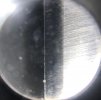- Joined
- Oct 30, 2018
- Messages
- 219
So,
I’m really struggling to fully remove the burr on my sabatier branded stainless knives. No idea of the exact stainless composition.
Tried both progressively lighter edge trailing and edge leading strokes, stropping on leather, cork, etc.
Being doing my best to minimise/remove the burr on every stone before progressing but even on my 3000 stone it just keeps flipping over and is becoming flipping annoying. After a lot of time and effort I can remove the majority of it but there still seems to be small sections remaining and if I work overly hard on those I can accidentally raise a burr in another area. I’m spending more time removing burrs than I am actually sharpening!!!
Any ideas? I’ve read through a decent amount of posts on this subject but still struggling...
I should add, been using a sharpie when stropping on the stone just to make sure I’m hitting the apex. It seems I am. Sharpness isn’t an issue, able to cleaning slice newspaper against the grain (apart from when it hits the burr!)
I’m really struggling to fully remove the burr on my sabatier branded stainless knives. No idea of the exact stainless composition.
Tried both progressively lighter edge trailing and edge leading strokes, stropping on leather, cork, etc.
Being doing my best to minimise/remove the burr on every stone before progressing but even on my 3000 stone it just keeps flipping over and is becoming flipping annoying. After a lot of time and effort I can remove the majority of it but there still seems to be small sections remaining and if I work overly hard on those I can accidentally raise a burr in another area. I’m spending more time removing burrs than I am actually sharpening!!!
Any ideas? I’ve read through a decent amount of posts on this subject but still struggling...
I should add, been using a sharpie when stropping on the stone just to make sure I’m hitting the apex. It seems I am. Sharpness isn’t an issue, able to cleaning slice newspaper against the grain (apart from when it hits the burr!)
Last edited:





